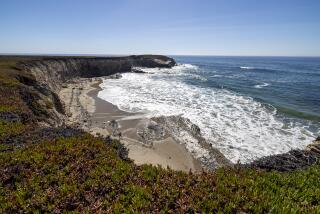Coastal Commission staff calls for shrinking a proposed Orange County beach development
In another twist in the struggle over one of the biggest coastal developments proposed in years, the staff of the California Coastal Commission has recommended that Newport Banning Ranch backers significantly shrink their project to protect wildlife habitat.
The recommendations, released Friday, set the stage for a pitched battle at the commission’s Sept. 7 hearing in Newport Beach, when the panel is scheduled to vote on the project.
The proposal to erect nearly 900 homes, a 75-room resort hotel and a retail complex on the largest private, undeveloped coastal parcel in Southern California has highlighted tensions at the commission, which regulates development along the state’s 1,100-mile coastline.
In February, commissioners – who are political appointees – fired Executive Director Charles Lester, stirring widespread criticism that they were trying to make the agency friendlier to developers.
At the same time, a number of commissioners, including Chairman Steve Kinsey, made it clear that they wanted to approve some version of the Banning Ranch development, which would rise on an old Orange County oil field next to the mouth of the Santa Ana River.
Last fall the staff recommended denial of a larger version of the project after finding that much of the 401-acre tract, though disturbed, provided important habitat for rare plants and animals, and harbored one of the only reasonably intact wetland-bluff ecosystems left on the Southern California coast.
We are deeply concerned and disappointed that the staff report does not appear to reflect the discussions or the agreements we have made with them.
— Newport Banning Ranch spokesman Sam Singer
Under pressure from Kinsey and other commissioners who disputed the environmental assessments of staff scientists, the staff backpedaled in April and recommended approval with restrictions that would confine the development footprint to about 55 acres.
The staff’s latest recommendations cut that to roughly 20 acres, a size that would potentially eliminate the hotel and an unspecified number of residences in the project’s southern half.
“We are deeply concerned and disappointed that the staff report does not appear to reflect the discussions or the agreements we have made with them during the past year,” Newport Banning Ranch spokesman Sam Singer said.
“This in no way changes our plan,” he added.
Under Banning Ranch’s latest proposal, 329 acres – much of it wetlands that can’t be developed – would be set aside as a nature preserve. Oil production would continue at two locations totaling 15 acres. The hotel, commercial space, parks and 895 residences – a mix of single family homes and condos – would be clustered in the central and southern portions of the tract.
The development team, which includes an oil company that has co-owned the land for nearly two decades, is promoting the project as a way to clean up and open to the public a swath of scrub and wetlands dotted with rusting oil equipment and contaminated soil.
Embracing that argument, a number of commissioners have challenged staff conclusions that most of the tract is environmentally sensitive habitat that should remain off-limits to development.
The commission is not bound by the staff recommendations and can approve the developer’s plans. Commission observers say they can’t predict how the vote will go amid intense public scrutiny.
One complication stems from the fact that Kinsey won’t be part of the deliberations. In June, he recused himself from voting on the project after The Times revealed that he had twice failed to report private meetings with the Banning Ranch team, as required under the California Coastal Act.
In its new report, the staff pushes back against the developers’ arguments that a smaller project wouldn’t be economically viable and that the project would underwrite environmental cleanup of a prized coastal site.
The Coastal Act doesn’t “require that this commission guarantee developers a profitable return on their investments,” the report states. It also notes that under state law, oil field operators are required to restore land when production ceases.
The staff concluded that slashing the development footprint is necessary to protect foraging areas for wintering burrowing owls, a state species “of special concern.” Previously, the staff had identified only a small area as owl habitat, a designation sharply criticized by a raptor expert who wrote the commission on behalf of project opponents.
In a detailed 12-page letter, zoologist Peter Bloom said that unless the grasslands that provide food for the owls are also saved, the birds would vanish from one of the few places they can be found in Orange County.
The staff also cited tribal concerns that there hasn’t been enough archaeological testing to ensure the development doesn’t destroy Native American sites. Previous archaeological digs have found a single burial site, artifacts and evidence of camps at Banning Ranch, which is adjacent to documented prehistoric village sites.
The developer commissioned another archaeological survey this summer, but the staff said it has not reviewed the results.
Twitter: @boxall
ALSO
Steve Lopez reflects back on his 1,100 mile trek down the California coast
A dangerous confluence on the California coast: beach erosion and sea level rise
More to Read
Start your day right
Sign up for Essential California for news, features and recommendations from the L.A. Times and beyond in your inbox six days a week.
You may occasionally receive promotional content from the Los Angeles Times.







